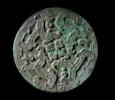‘Four Dragons’ Mirror
‘Four Dragons’ Mirror
Warring States Period, 481 B.C. – 221 B.C., Zhou Dynasty
China
Bronze
Diam: 11.6cm x Depth: 0.6 cm
Sold
A circular bronze mirror, polished to a high shine on one side to reflect. The reverse is decorated with a semi-abstract relief four dragons design. The dragons have long, angular bodies, with their heads and feet represented as curved points, and repeat around a central four-petalled boss. Delicate ridged line decoration fill the bodies of the dragons. A border of geometric ‘scale bands’ runs around the circumference of the mirror. Green patination and malachite encrustations appear across both surfaces.
Bronze mirrors were produced in China from Neolithic times, with early examples found in tombs of Qija culture, late Neolithic period, and Shang tombs at Yinxu. During the Warring States period, mirror making proliferated, with examples found in many regions demonstrating greater technical craftmanship and richer decorative motifs. During this period, bronzes were increasingly popular as individual luxury items. Warring States period mirrors can be divided into northern and southern types: those from the north are plainer, while those from the south (such as this example) are delicate and elaborately decorated. The decorations resemble those on contemporary luxury items in jade, lacquer, and textiles. Mirrors generally had a central knob or loop so that they could be easily held in the hand.
Bronzes chinois des dynasties Tcheou, Ts’in et Han, Musée de l’Orangerie, Paris, 25th May – 18th June 1934.
Gallery II, International Exhibition of Chinese Art, Royal Academy of Arts, London, 1935
S. Umehara, ‘Two Ancient Chinese Mirrors’, Kôkogaku Zasshi (Tokyo, January 1930), XX:1, pp. 20-27.
Bronzes chinois des dynasties Tcheou, Ts’in et Han, Musée de l’Orangerie, Paris, 25th May – 18th June 1934, cat. no. 406, p. 208.
International Exhibition of Chinese Art, Royal Academy of Arts, London, 28th November 1935 – 7th March 1936, cat. no. 424, p. 32.
International Exhibition of Chinese Art: Illustrated Supplement to the Catalogue, Royal Academy of Arts, London, 28th November 1935 – 7th March 1936, cat. no. 424, p. 41.
H. F. E. Visser, Asiatic Art in Private Collections of Holland and Belgium (Amsterdam and Ireland, 1947), pp. 45-46, pl. 49, no. 79.
Georges A. Salles and Daisy Lion-Goldschmidt, Collection Adolphe Stoclet: choix d'oeuvres appartenant a Madame Feron-Stoclet (premiere partie) (Brussels, 1956), pp. 338-341.
Previously in the Private Collection of Adolphe Stoclet (1871-1949), Brussels, Belgium, from at least 1934.
Thence by descent to his daughter, Madame Raymonde Feron-Stoclet (1897-1963), Brussels, Belgium.
Thence by descent.
ALR: S00233605, with IADAA Certificate, this item has been checked against the Interpol database.
Adolphe Stoclet (1871-1949) was born to a family of Belgian bankers in Saint-Gilles, Belgium, on 30th September 1871. He studied civil engineering at the Free University of Brussels, and worked for Italian and Austrian railway companies from 1894 onwards. After his return to Brussels in 1904, he took a job with the Compagnie Internationale de Chemins de Fer, and was promoted to chairman in 1927. Stoclet became one of the directors of the Société Générale de Belgique, one of the largest holding companies in Belgium at the time. Described by contemporaries as charming but slightly pompous, Stoclet’s large beard was seen as one of his defining features – it was compared to that of the Assyrian king Ashurbanipal.
Stoclet’s wife, Suzanne, was the daughter of the art critic, historian, collector, and dealer Arthur Stevens (1825-1909) and the niece of painter Alfred Stevens (1823-1906). Through these relations, the Stoclets formed connections with avant-garde art circles in Paris. The couple entertained European royalty, as well as historians, archaeologists, writers, and musicians.
The Stoclets met architect Josef Hoffman (1870-1956), leading figure of the Vienna Succession Movement and one of the founders of the Wiener Werkstätte, while in Vienna overseeing the construction of a railroad. The couple had been on a stroll through the city, viewing the architecture, when they happened upon a villa on the Hohe Warte, where Hoffman had built a colony of modernist houses for artists and the supporters of the Vienna Succession Movement. They shortly commissioned him to design a grand mansion in Brussels in 1905. Despite complications in the design and huge funding requirements, they persisted with building what is now considered one of the great examples of Vienna Secession architecture. Hoffman tasked the best designers working at the Wiener Werkstätte with the project, including Koloman Moser, Carl Otto Czeschka, Ludwig Heinrich Jungnickel, and Emilie Schleiss-Simandl. Notable artists, such as Gustav Klimt, Richard Luksh, Georges Minne, Franz Metzner, and Fernard Khnopff were charged with the interior decoration. The mosaic frieze in the dining room was the last monumental piece produced by Klimt before his death in 1918. The palace’s proto-modernist appearance and unity of style aligned with Richard Wagner’s concept of Gesamtkunstwerk, even down to the smallest details of doorknobs and cutlery. According to art historian Edmond de Bruyn, ‘It was self evident that the floral decoration of the house – always kept in one colour tone – and the neckties of Monsieur Stoclet matched Madame’s dress.’ The family was able to move into Stoclet Palace in 1911, though the furnishings were not yet complete.
The collection stored in the palace was eclectic and encyclopaedic, featuring art from ancient China, Cambodia, Egypt, Mesopotamia, pre-Columbian Mexico, and tribal Africa, alongside late medieval Italian painting, metalwork, enamels, and relics. The Stoclets resided in the palace until 1949, when Adolphe died on 3rd November, and Suzanne followed a fortnight later. Their art collection was divided between their three children, René (b. 1902), Jacques (b. 1903), and Raymonde (1897-1963). Stoclet Palace, now listed as a UNESCO World Heritage site and a Belgian landmark since 1976, is still occupied by their heirs today.










 Enquire
Enquire




